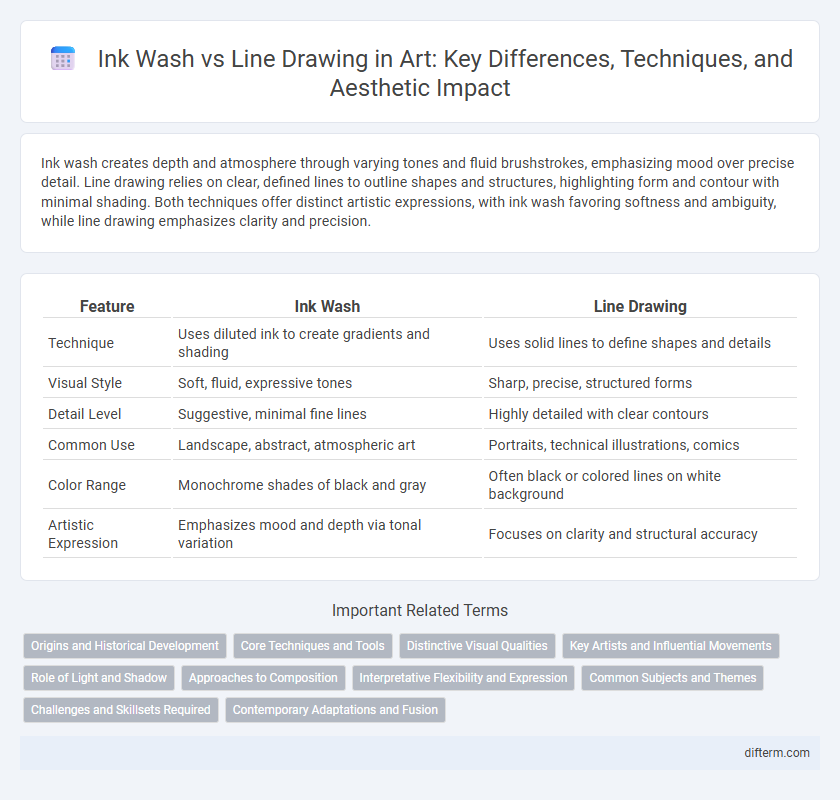Ink wash creates depth and atmosphere through varying tones and fluid brushstrokes, emphasizing mood over precise detail. Line drawing relies on clear, defined lines to outline shapes and structures, highlighting form and contour with minimal shading. Both techniques offer distinct artistic expressions, with ink wash favoring softness and ambiguity, while line drawing emphasizes clarity and precision.
Table of Comparison
| Feature | Ink Wash | Line Drawing |
|---|---|---|
| Technique | Uses diluted ink to create gradients and shading | Uses solid lines to define shapes and details |
| Visual Style | Soft, fluid, expressive tones | Sharp, precise, structured forms |
| Detail Level | Suggestive, minimal fine lines | Highly detailed with clear contours |
| Common Use | Landscape, abstract, atmospheric art | Portraits, technical illustrations, comics |
| Color Range | Monochrome shades of black and gray | Often black or colored lines on white background |
| Artistic Expression | Emphasizes mood and depth via tonal variation | Focuses on clarity and structural accuracy |
Origins and Historical Development
Ink wash painting, originating in ancient China during the Tang Dynasty (618-907 AD), emphasizes fluid brushstrokes and tonal variations to evoke natural landscapes, becoming a cornerstone of East Asian art. Line drawing, with roots tracing back to prehistoric cave art and classical Greek vase painting, developed through the Renaissance as a method to define form and structure using precise contour lines. Both techniques evolved independently, influencing artistic expression by focusing on either tonal gradation or defined edges, shaping distinct cultural art histories.
Core Techniques and Tools
Ink wash art relies on varying ink dilution and brush pressure to create gradients and tonal depth, emphasizing fluid brushstrokes and subtle shading. Line drawing primarily uses steady, controlled pen or pencil lines to define form and outline with precision, focusing on contour and detail rather than tonal variation. Core tools for ink wash include brushes and sumi ink, while line drawing typically employs fine liners, graphite pencils, and technical pens for crisp, defined lines.
Distinctive Visual Qualities
Ink wash art features fluid gradients and soft transitions created by varying ink dilution, emphasizing tonal depth and atmospheric effects. Line drawing relies on precise, continuous lines to define shapes and contours, prioritizing clarity and structural accuracy over tonal variation. These contrasting visual qualities showcase ink wash's emphasis on mood and texture versus line drawing's focus on form and detail.
Key Artists and Influential Movements
Ink wash, prominently used by Chinese artists like Sesshu Toyo during the Muromachi period, emphasizes tonal variation and fluid brushstrokes to convey atmosphere and depth, while line drawing, central to artists such as Albrecht Durer in the Northern Renaissance, focuses on precise contours and detailed hatching to define form. The literati painters of the Song and Yuan dynasties advanced ink wash with philosophical and poetic undertones, contrasting with the clarity and structure championed by the Italian Renaissance's linear perspective movement. Both techniques remain foundational, influencing modern artists who integrate Eastern ink wash's spontaneity with Western line drawing's meticulousness.
Role of Light and Shadow
Ink wash art utilizes gradients of ink to create depth through subtle variations in light and shadow, emphasizing atmospheric effects and tonal transitions. Line drawing relies on contours and hatching techniques to suggest form and shadow, using light and dark lines to define edges and volume. The interplay of light and shadow in ink wash produces a more fluid, emotive quality, whereas line drawing offers precise, structural representation.
Approaches to Composition
Ink wash emphasizes fluidity and tonal variation, allowing artists to create depth and atmosphere through gradients and subtle shading. Line drawing relies on precise, controlled lines to define shapes and structure, emphasizing contours and form with clarity. Both approaches use composition techniques to guide the viewer's eye, but ink wash often leverages negative space and value contrasts, while line drawing focuses on line weight and direction for compositional balance.
Interpretative Flexibility and Expression
Ink wash art emphasizes tonal variation and fluidity, allowing for interpretative flexibility through gradients and ambiguous forms that evoke emotion and atmosphere. Line drawing relies on precise contours and defined shapes, offering clarity and directness but potentially limiting expressive ambiguity. The contrast highlights how ink wash fosters mood and subjective interpretation, while line drawing delivers structured and explicit representation.
Common Subjects and Themes
Ink wash and line drawing often share common subjects such as landscapes, portraits, and nature scenes. Both techniques emphasize form and texture, with ink wash highlighting tonal variations and line drawing focusing on contours and details. These methods frequently explore themes of simplicity, movement, and the interplay of light and shadow.
Challenges and Skillsets Required
Ink wash demands mastery of tonal variation and fluid brush control to create depth and subtle gradients, requiring artists to anticipate drying times and ink absorption on paper. Line drawing emphasizes precision and confident stroke execution, relying on strong hand-eye coordination and the ability to convey form through varied line weight and contour. Both techniques challenge artists to balance spontaneity with control, demanding distinct yet complementary skill sets.
Contemporary Adaptations and Fusion
Contemporary adaptations of ink wash and line drawing techniques blend traditional East Asian aesthetics with modern art practices, creating hybrid visual languages that emphasize fluidity and precision. Artists increasingly fuse the expressive gradients of ink wash with the stark clarity of line drawing to explore new textures and spatial dynamics in both abstract and figurative works. This fusion challenges conventional boundaries, enriching contemporary art with innovative methods that highlight the interplay between spontaneity and control.
ink wash vs line drawing Infographic

 difterm.com
difterm.com